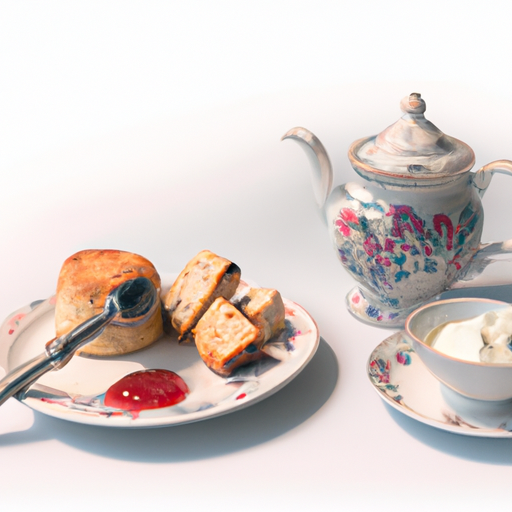Are you aware that English Breakfast tea is among the most widely loved blends of black tea globally?
With its bright and flavorful taste, it’s no wonder that people all over the globe start their day with a cup of this delightful beverage.
But with so many options available online, how do you know which English Breakfast tea is the best?
Well, fear not, because I’ve done the research for you. In this article, I’ll be sharing the top brands and varieties of English Breakfast tea that you can buy online.
From the milder and lighter blends to those with a stronger kick, there’s something for everyone’s taste.
So whether you prefer a straight Keemun tea or appreciate the blending techniques of The Tea Spot, I’ve got you covered.
Let’s dive in and find your perfect cup of English Breakfast tea!
Key Takeaways
- English Breakfast tea is a blend of black teas that create a bright and flavorful cup.
- It is more mild compared to Irish Breakfast and Scottish Breakfast tea.
- English Breakfast tea contains caffeine, with a standard cup containing 35 to 50 milligrams.
- There are various brands that offer English Breakfast tea options, each with its own unique flavor profile.
Types of English Breakfast Tea
I’ve learned that there are several brands that offer different types of English Breakfast tea, including Teabox, Art of Tea, Tea Leaves, Tielka Tea, Harney & Sons, Twinings of London, The Tea Spot, and Taylors of Harrogate.
When it comes to the flavors of English Breakfast tea, it’s important to note that each brand will have its own unique blend. English Breakfast tea tends to be more mild compared to its counterparts, Irish Breakfast and Scottish Breakfast tea.
The main difference between English and Irish Breakfast tea lies in the type of black tea used. English Breakfast tea typically consists of a blend of Ceylon, Assam, and Keemun black teas, while Irish Breakfast tea is usually made with Assam black tea. These variations in the blend result in different flavor profiles, with English Breakfast tea offering a brighter and more flavorful cup.
Brands and Varieties
Taylors of Harrogate offers a traditional blend of black teas that’s bright and refreshing. Known for its consistency and quality, Taylors of Harrogate’s English Breakfast tea is a standout among the best brands available online.
The flavor profile of this tea is well-balanced, with a brisk and robust taste that’s both invigorating and satisfying. The blend of black teas used in Taylors of Harrogate’s English Breakfast tea creates a harmonious combination of flavors, with notes of malt and a hint of sweetness.
This tea is perfect for those who enjoy a classic and traditional cup of English Breakfast tea. With its bright and refreshing taste, Taylors of Harrogate’s English Breakfast tea is sure to please even the most discerning tea connoisseur.
How to Make English Breakfast Tea
Luckily, brewing a delightful cup of English Breakfast tea is quite simple. To start, warm your cup by rinsing it with hot water.
Next, add the desired amount of loose leaf tea or a tea bag to the cup. Pour hot water over the tea and let it steep for 3-5 minutes, depending on your preference for strength.
After steeping, strain the tea leaves or remove the tea bag. Now, it’s time to enhance the flavor. Some people enjoy adding a touch of sugar or a splash of milk to their tea, but it’s completely optional.
The benefits of drinking English Breakfast tea include a boost of caffeine to kickstart your day, as well as its bright and flavorful taste. When choosing the right brand, consider your personal preferences, such as the aroma, flavor profile, and sourcing of the tea leaves.
Whether you prefer a sweet and woody blend like Teabox, a robust and slightly earthy blend like Tea Leaves, or a toasty and strong blend like Harney & Sons, there is a perfect English Breakfast tea out there for you.
Frequently Asked Questions
What are the health benefits of drinking English Breakfast tea?
Drinking English breakfast tea can provide health benefits due to its antioxidants. It may aid in weight loss by boosting metabolism. However, it’s important to maintain a balanced diet and exercise regularly for optimal results.
Can English Breakfast tea be enjoyed without adding milk or sugar?
Yes, English breakfast tea can be enjoyed without adding milk or sugar. The brewing time does affect the taste, with a longer steeping time resulting in a stronger and more robust flavor. English breakfast tea pairs well with pastries, scones, and biscuits.
Are there any decaffeinated options available for English Breakfast tea?
Yes, there are decaffeinated options available for English Breakfast tea. If you prefer to avoid caffeine, you can try alternatives like herbal teas or decaffeinated black tea blends.
Can English Breakfast tea be enjoyed iced or cold brewed?
Yes, English Breakfast tea can be enjoyed iced or cold brewed. To make iced English breakfast tea, steep the tea in hot water, let it cool, and pour over ice. For cold brewed English breakfast tea, steep the tea in cold water overnight in the refrigerator.
Are there any herbal or fruit-infused versions of English Breakfast tea available?
Sure, there are herbal and fruit-infused versions of English Breakfast tea available. They offer unique flavors to try, such as Earl Grey with lavender or English Breakfast with hints of citrus. These variations can add a refreshing twist to your tea experience.










